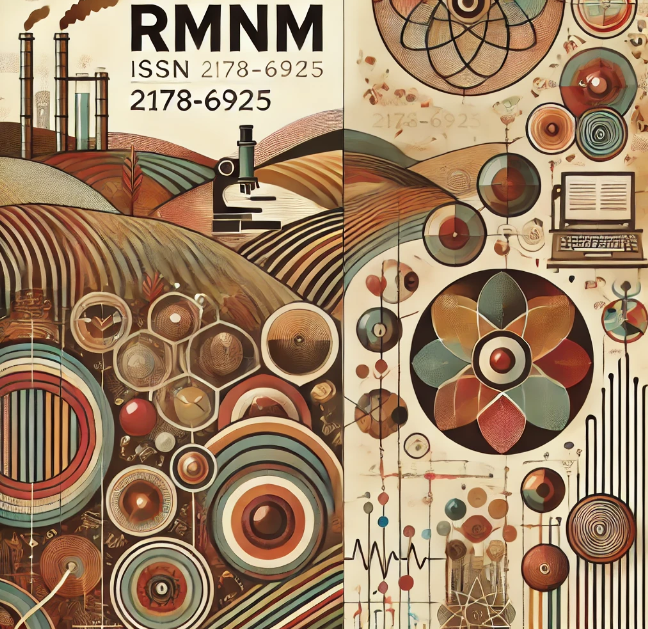POSITIVE USE OF ENDOPHYTIC FUNGI FOR PATHOGEN BIOCONTROL IN TOMATO CROPS
DOI:
https://doi.org/10.61164/rmnm.v9i1.2807Keywords:
Systemic Resistance. Secondary Metabolites. Microbial Ecology.Abstract
The use of endophytic fungi for biocontrol of pathogens in tomato crops is a promising alternative in the scenario of sustainable agriculture. Endophytic fungi are microorganisms that live inside plant tissues without causing damage, benefiting plants in several ways, including promoting growth, inducing systemic resistance and directly suppressing pathogens. The objective of the study was to evaluate the potential of different strains of endophytic fungi in the biocontrol of pathogens that affect tomato crops, seeking ecological alternatives to the use of chemical pesticides. The review methodology involved the careful selection of scientific articles published in renowned journals. Academic databases such as PubMed, Scopus and Web of Science were used to find relevant studies. The adoption of this practice can significantly contribute to reducing the use of chemical pesticides, promoting more sustainable and healthy agriculture. The review also points to the need for additional research to better understand plant-fungus interactions and develop efficient application protocols. Knowledge transfer between the scientific community and farmers is essential for the successful implementation of this technology in agriculture.
References
CHAGA, Larissa Moreira; RODRIGUES, Tatiana Tozzi Martins Souza; SILVA, Geovana Gonçalves. Metabólitos de fungos endofíticos da mata seca com potencial de biocontrole de sclerotinia sclerotiorum. Natural Resources, v. 13, n. 1, p. 71-82, 2023. Acesso em: 15 mar. de 2024.
DA SILVA, Esmeraldo Dias et al. Controle biológico de patógenos pós-colheita em videira. Scientific Electronic Archives, v. 16, n. 8, 2023. Acesso em: 2 mar. de 2024. DOI: https://doi.org/10.36560/16820231760
DE CARVALHO MOREIRA, Bárbara et al. Bioagentes na supressão da vassoura-de-bruxa e promoço de crescimento na cultura do cacaueiro. Ipê Agronomic Journal, v. 5, n. 1, p. 1-9, 2021. Acesso em: 25 mar. de 2024. DOI: https://doi.org/10.37951/2595-6906.2021v5i1.6546
DE MARCO, Kássio; SANTOS, Aline Ferreira; SOUZA, William. Biocontrole da Sclerotinia sclerotiorum por bactérias do gênero Bacillus. REVISTA, p. 42, 2021. Acesso em: 5 abr. de 2024.
FERREIRA, Tatiani Pereira et al. Prospecção de fungos Endofíticos isolados de plantas cultiváveis e não cultiváveis e seus efeitos na quebra de dormência de sementes de capim Andropogon L. DELOS: Desarrollo Local Sostenible, v. 16, n. 43, p. 716-733, 2023. Acesso em: 20 abr. de 2024. DOI: https://doi.org/10.55905/rdelosv16.n43-015
FREIRE, Antonia Fábia et al. Importance, challenges and perspectives of using fungi in the biological control of plant diseases for Brazilian agriculture: Importância, desafios e perspectivas de uso de fungos no controle biológico de doenças de plantas para a agricultura brasileira. Concilium, v. 24, n. 1, p. 485-504, 2024. Acesso em: 7 mar. de 2024. DOI: https://doi.org/10.53660/CLM-2744-24B11
JUNIOR, Aloisio Freitas Chagas et al. Controle biológico do fungo Rhizopus sp. em morangos pós-colheita. Revista da Universidade Vale do Rio Verde, v. 21, n. 1, p. 1-12, 2022. Acesso em: 12 abr. de 2024.
MATOS, Amanda Dayanne Malta et al. Levantamento de fungos presentes em espécies vegetais da mata seca na microrregião de Januária–MG. Seven Editora, 2024. Acesso em: 18 ma. de 2024.
MORAES, G. K. A.; FERRAZ, Luana Fernandes; CHAPLA, Vanessa Mara. Compostos orgânicos voláteis de fungos endofíticos e suas aplicações biotecnológicas. RVq, v. 12, n. 6, p. 1498-510, 2020. Acesso em: 18 abr. de 2024. DOI: https://doi.org/10.21577/1984-6835.20200116
SOUTO, Ana Clara et al. Desenvolvimento inicial do milho com uso de microrganismos. ENCICLOPEDIA BIOSFERA, v. 17, n. 32, 2020. Acesso em: 30 mar. de 2024. DOI: https://doi.org/10.18677/EnciBio_2020B60
TORRES, Flavia Luana et al. Bioprospecção e potencial biotecnológico de fungos endofíticos associados a plantas do Cerrado. Concilium, v. 22, n. 2, p. 256-272, 2022. Acesso em: 4 ma. de 2024. DOI: https://doi.org/10.53660/CLM-114-133
Downloads
Published
How to Cite
Issue
Section
License
Copyright (c) 2024 Revista Multidisciplinar do Nordeste Mineiro

This work is licensed under a Creative Commons Attribution-NonCommercial-ShareAlike 4.0 International License.




